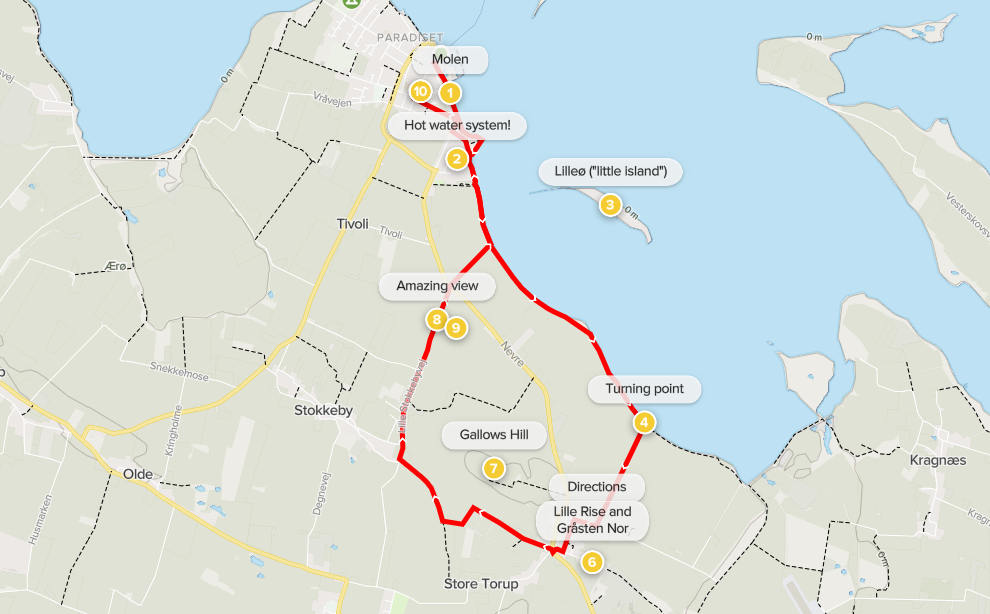Ærøskøbing
The Great Storm and Gallows Hill
Easy
2 hours
10 km
The route starts by the harbour - the bus stop is there too and there is parking. Ærøskøbing is also the best place on the island for accommodation and restaurants.
The walk includes the iconic path along Molen, Gallows Hill, and an amazing view of the archipelago. In July the first stretch, known as the Nevresti, can be busy with walkers and homicidal silent cyclists. In several places this walk follows the Øhavssti.
Molen is the name of the famous path by the sea in Ærøskøbing, with poplars towards the water and the back of the charming old fishermen’s houses and “skipper houses” on the other side.
The brick tower of the firestation at the end of Molen is where they used to hang the hosepipes to dry.
As you leave town behind, passing the communal solar heating system and the shelters at Villa Blomberg, you can see a small island directly out to sea - called, with typical Danish flair, “small island” (“Lilleø”). This was where Anne and Rasmus Hansen had their farm when the appalling storm and flood of 1872 struck. Rasmus was working in Ærøskøbing and unable to get back to Anne. As the blizzard raged and the waters rose, submerging the island, Anne secured their cows and took shelter in the attic of the farmhouse. Amazingly, when Rasmus sailed out the next day after the storm had abated, he found her still there, having survived the night. Many others in southern Denmark were not so fortunate.
The view east over the airfield towards Marstal is worth enjoying for a moment.
The airfield itself is on borrowed time, being on the lowest part of the island, Gråsten Nor. Like the other inlets at Vitsø and Stokkeby, this whole area was part of the sea, but was drained in the 19th century. Until that time Ærø was almost two islands - West Ærø and Little Ærø (Marstal). Only the causeway, where the main road now runs, linked the two.
Beyond Marstal you can see the island of Langeland (although it has a bridge, sadly, so is not a real island).
You might mark the relative absence of trees on Ærø (and elsewhere in southern Denmark). There is a myth that they were used for boatbuilding - but more were used for fuel, including by the brickworks. But the Danes prefer to blame the Swedes for things when they can, and so the Swedish occupation of Ærø in 1658/9 usually gets the blame. They did apparently devastate the island and burn at least some of the remaining forest.
Galgebakken (Gallows Hill) lies up to the right as you walk along the pretty wooded path at 5.5km. It looks unassuming but has dark secrets. Many stone age and bronze age burial sites were found here - and then it became the site of executions, presumably chosen so the corpses of the wrongdoers could be seen swinging in the breeze from afar as a deterrent. The last recorded hanging, in 1714, was of Anders Christensen and his wife, from nearby Thorup, who murdered their landlord, Jens Hansen, for his money. Worse, they took communion afterwards, for which they not only were hanged, but their remains left somewhere on Galgebakken. It seems probable that in 1727 Rasmus Hansen and his stepdaughter were also executed here for incest, but their crime was deemed so shocking little seems to have been recorded. The tracks by Galgebakken are not somewhere to linger after dark.
View! Having schlepped along the road from Stokkeby you are rewarded, as you crest the hill, with fabulous view of the islands and Ærøskøbing. Lilleø, where Anna Hansen survived the great storm, is right in front, with Ommel, Strynø and Langeland beyond, and Tåsinge (where Elvira Madigan met her fate) to the left.
There is also a stone age burial site to your right, in the lump of shrubs in the next hedgerow. One of many on Ærø, this one was unfortunately dismantled for the stones which were used in the foundations of the yellow house dead ahead. This one is not worth investigating further - there are better ones elsewhere on Ærø (Jættestue and Lindsbjerg in particular).
Restaurants - Ærøskøbing has a lot of good ones nowadays, from Arnfeldt, which is pushing for a Michelin star, down to the best burger takeaway in Denmark, Lenda’s. They are all pretty good so just choose whichever suits you. My favourite cafe is the characterful gamle Købmandsgård (with whisky distillery) in the square by the church.
Places to stay - there is lots of ,accommodation too, but book ahead in high season. The camping shelters by Villa Blomberg which you pass en route, are fun. Ærøskøbing campsite has unfortunately had bad press in 2021 so maybe check it out before committing.




